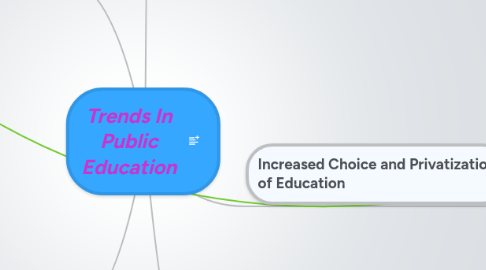
1. High School Reform
1.1. The reform is to make classes more relevant and better prepare students for college. The non-college bound students will have more vocational classes available to them so as to better prepare them for life after high school.
1.1.1. International Baccalaureate programs are being implemented to better prepare students for college courses.
1.2. Schools are creating schools within the schools
1.2.1. Schools focusing on Biotechnology, information technology, math and science, and engineering help to better focus students in their fields, preparing them for their college courses and degree programs.
1.2.2. Schools within the schools are sometimes created to increase enrollment while others are created to meet a demand for more specific classes.
1.3. Some schools are asking students to declare a major as early as 8th grade, better allowing their high school classes to focus in on their intended major.
1.3.1. This will allow the high school curriculum to become more competitive and challenging, like college courses.
2. Increased Reliance on Technology in the Classroom
2.1. Technology will become more integrated into the classrooms, allowing the future to use digitized state standards tests.
2.1.1. This will allow the results to be available quicker and allow school reforms to happen quicker as well.
2.2. Online schooling has become more popular, especially for students in rural areas.
2.3. Media is a valuable tool for in the classroom and blogging will be utilized more by teacher and students
2.3.1. Blogging allows classroom discussions to continue as homework, documenting the ideas for later review by teacher.
2.4. Teachers must now have more prominent skills with technology in order to take advantage of the resources.
2.4.1. As technology advances, the generations keep becoming more adapt at utilizing it. The new teachers being trained now are already familiar with technology and it keeps getting easier for each generation to understand.
3. An Older and More Diverse United States Population
3.1. By the year 2050, retirement population (65+) is expected to double.
3.1.1. This was caused by better health care and medical advances, increasing lifespan.
3.2. By 2050, the wage earners will decrease in relation to elderly and young. There will be 72 elderly and young to ever 100 wage earners.
3.2.1. The elderly will have no kids in the public school system, more likely to vote against any measure to increase funding to public schools; i.e. raising taxes.
3.2.1.1. More money will be needed to pay for medicare for elderly, taken away from school funding.
3.3. Freedom to Work Act makes it so retired workers no longer need to report earned wages, they are able to work without limit and without penalty.
3.3.1. Less taxes are being collected off the elderly, while more money is being spent on their health care. This leaves less taxes for the school system.
4. Increased Choice and Privatization of Education
4.1. Choices to attend another public school based on availability, charter school, home school, virtual school, or public voucher to a private school.
4.1.1. Some Virtual schools have limits allowing students to only take one or two classes a semester, ensuring they attend traditional school as well.
4.1.2. There are 4,000 Charter Schools nationwide. Mainly in Arizona, California, Michigan, and Texas.
4.1.2.1. Charter Schools are run by Educational Management Organizations (EMOs). They have experience and resources to successfully start a charter school.
4.1.2.1.1. EMOs hire teachers in order to give them less expensive benefits than the state would. Not liked by Teacher Unions but beneficial to Charter schools
4.1.3. When Parents are given the choice to move their students, there will be more mid-year moves, dividing the schools racially. This will leave public schools with the hard-to-serve students.
4.1.3.1. "Out of slightly more than 57 million k-12 schoolchildren, almost 29.4 million- nearly 52%- are enrolled in a k-12 school choice option."
4.1.3.1.1. 26 States have a cap on charter school growth, either limiting the number of students per school or the number of schools per local district or state.
5. Changing Role of Government in Education
5.1. The government is now more involved in the school system. No Child Left Behind (NCLB) ensured that the state would better monitor the progress of students through state testing. States are held accountable for the progress of the students. Before this was considered a matter for the local school board.
5.1.1. There is not enough federal funding to uphold all the mandates made in NCLB. Due to the insufficient funding, the number of schools closing, being converted to charter schools, and being taken over by the state is increasing.
5.1.1.1. The state is reluctant to take over too many schools and some are being left in limbo essentially. They have low testing scores but no money to buy enough supplies to help change it.
